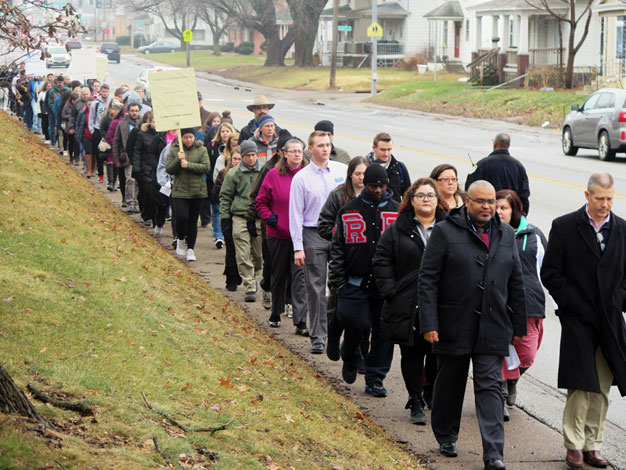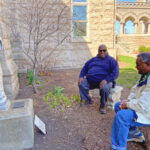
St. Ambrose University students and staff in Davenport participate in a Martin Luther King Day march for racial justice in this file photo.
By Anne Marie Amacher
The Catholic Messenger
DAVENPORT — Shakti Butler, a filmmaker and educator in the field of social and racial equality, led participants of a two-day conference through history as she guided them to explore working toward racial justice and healing. The Ambrose Women for Social Justice Conference took place online last month.
Butler is president and founder of World Trust Educational Services Inc., an organization dedicated to racial justice and healing through film, curricula and programs that spark institutional, structural and cultural change. The first day of the conference “Framing a Racial Justice Foundation,” focused on uncovering and interrogating the system of racial inequality that impacts the way people think and act in the world. The second day focused on “Healing and Racial Imagination” to encourage conversation and working toward healing the wounds of racial injustice.
Butler observed that love is justice that inspires people in fairness and awareness. To get to that point, Americans need to look at the past to understand the roots of today’s realities. She noted that Europeans colonized 85-90 percent of the world, bringing their thinking, traditions and ways of life to each place they settled. They brought capitalism, but also needed labor.
Colonization led to supremacism and capitalism, which involved slavery, genocide, “invisible” labor, femicide/child abuse, ecocide and exploitation of resources. All of these activities lead to trauma, she said. A system of inequality is interconnected and movable. History, identification and culture becomes embedded in people.
She showed a video on Native Americans being “civilized” through school systems that aimed to eradicate their Native American culture. Many natives resisted, she said. Continuing through history, “Notice how the system of inequities continues to show up.”
The 1790 Naturalization Act, for instance, applied to “free white persons” only until 1952. Lawmakers did not adjust the law until 1965. Despite that fact, today “we still have kids locked up in cages.”
The Removal Act of 1830 moved Native Americans west of the Mississippi River to make room for white people. Tribes had to agree to give up their homelands. When a territory became majority white, those areas could become states.
Jim Crow laws intimidated Blacks. (These laws “were a collection of state and local statues that legalized racial segregation … for about 100 years, from the post-Civil War era until 1968” and “were meant to marginalize African Americans by denying them the right to vote, hold jobs, get an education or other opportunities” – history.com/topics/early-20th-century-us/jim-crow-laws).
Black citizens could not change employment without a supervisor’s permission, ride a freight car without permission or engage in sexual activity or loud talk with a white woman. “It’s slavery by another name,” Butler said.
She pointed out other laws that favored white people. The Federal Housing Administration, established in 1934, aimed to help Americans become homeowners. However, 98% of the loans went to white people. Without fair housing, Black people had less access to jobs, food, education and other life necessities. Likewise, the Social Security Act of 1935 created a safety net for retirement but excluded agricultural workers and domestic servants – jobs held predominantly by African American, Mexican and Asian workers.
The list continued: the 1935 Wagner Act granted unions the power of collective bargaining. However, it excluded non-whites, denying them access to better pay and jobs. “Many craft unions remained nearly all white until the 1970s,” Butler said. The 1956 Federal Aid Highway Act helped increase mobility. The downside: businesses started moving farther out of the city to where land was cheaper. That left behind employees who could not afford to move out of the city.
For social change to happen, “We have to hear the voices of the marginalized,” Butler said. “Bring them to the table with access.” Healing and transparency are necessary. “It’s about freedom.”
This trauma rooted in American history disrupts the default network in the brain and has affected self-esteem. Understanding the system of inequality that dates back centuries is necessary in order to heal, she said during the second day of the conference. People need to come together to talk and to listen. She told participants that the body’s natural response to trauma is fight, flight, freeze, submit, disassociate. “We need to learn to deal with trauma to love ourselves.”
Racial imagination, she said, involves fleshing out dreams of the future. Think about how policy is created, do a power analysis on who makes change and how to get to those people. This must be done in a collective attempt. “Everything is connected. Yes, you can change the world — at least your world,” she told participants.
(The two-day conference was part of the St. Ambrose University College of Arts and Sciences 2020-21 Academic Theme, The Changing Climates: From Rising Seas to Societal Needs.)











